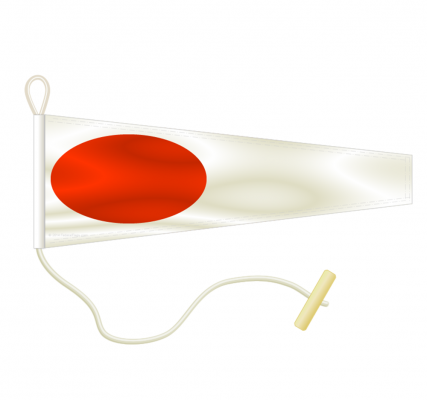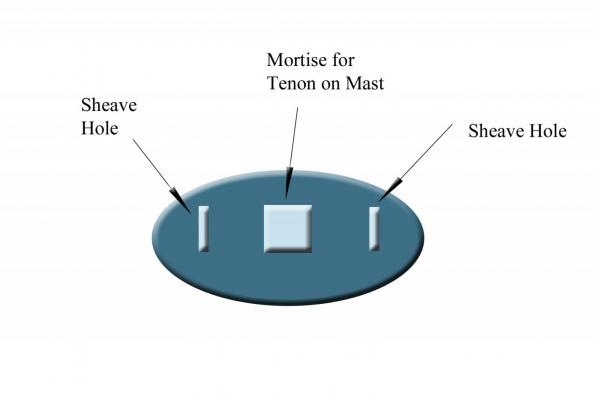-
Posts
1,912 -
Joined
-
Last visited
Content Type
Profiles
Forums
Gallery
Events
Posts posted by popeye2sea
-
-
Joel, the standard described in your references may not refer to the Royal Standard (of the sovereign). It could refer to the standard of a particular Flag officer.
-
Druxey,
I would assume they had it figured out somehow.. maybe men below keeping the rope hanging down from tangling? I seriously doubt that cable reels (like power and telcos use) were available. I have a hard time just comprehending that they floated the masts to the ship and using manpower and sheers got the masts installed. Moving all that cordage out to the ship for rigging would have been an operation unto itself.
I wish there was more historical info, it would be fascinating to know how the heck they did things like this.
If you thought that stepping the masts was tough, you should read the description of swaying the tops up and setting them into place. There is a good description of the same and a diagram of setting up a mast in Steels' Art of Rigging, 1925
Most of the heavy lifting of the cross trees, tops, shrouds, stays to be got over the mast heads were lifted by means of girtline blocks lashed to the mast heads. Even the riggers who went aloft to accomplish all this were hoisted aloft by the girtlines.
-
Would it be difficult to reeve the crowsfeet through the euphroe and the top with the euphroe up close to the top and then haul out to the stay using the tackle, adjusting tension on individual legs as you go?
-
-
I works for any unit of measure because it is a ratio. As long as you convert both sides of the equation to the same unit you can calculate it. The method as Bob state above is to put the same unit of measure on both sides of the equation and cross multiply. Wayne is doing the same thing, just doing part of it in his head and not realizing.
1/8" scale is the same as saying
1/8" = 1ft. original ratio
= 1/8'= 12"/1 putting 1 foot into inches
cross multiply
1 x 1 = 1 and 8 x 12 = 96
= 1:96
-
There are some examples in the book on the Kriegstein Collection, and the authors mention that four of the models in their collection were originally fitted with poles for flags.
There is a painting of The Edgar, a 60-gun fourth-rate, 1758, that is shown in the book. It actually shows two ships, each with 5 flags. Both ships are flying the same flag arrangement.
Union Jack - bow
Admiralty Flag - fore mast
Royal Standard - main mast
Union Jack - mizzen mast
Red Ensign - ensign staff
Also two contemporary models of the Greyhoune, 6th rate, 1720, and the Diamond, 5th rate, 1723, show the exact same flag arrangement.
I did note too that the authors wrote good paragraph about flags at launching. Nothing revealing, but the do mention that launchings were festive events with royalty occasionally present. Do you suppose the Royal Standards are flown because royalty was present?
I assume the red, blue, or white ensigns would be flown depending on which squadron they were assigned to. That seems to be consistent across all examples. The Union Jack seems mostly consistent too.
Druxey, that foremast flag on the Royal Sovereign doesn't look like a Blue Ensign to me. Yet, it's not quite a Union Jack. Looks like a St. George's Cross on a blue field. Not sure what that would mean.
Clare
Not sure if they would be following the same procedures that we use today but the precedence of the flags in this example does point in that direction. The Union Jack on the the jackstaff (forward) and the Red Ensign (aft) would have been standard usage for all ships in that squadron. The highest ranking official present (Royal Standard) would take precedence at the main. The next in precedence (Admiralty) would be at the fore, and whatever lower official rated the union jack to show his rank would be at the mizzen.
Henry
-
On the actual ship the jeers would have been rove with the yard athwart the bulwarks on the fo'c'sle. The yard would then be swayed up using the jeers, and the truss tackles would be bowsed down to snug the yard in to the mast.
That should give you plenty of support and room to rig the jeers. Plus you will end up with a realistic amount of halyard to belay/coil.
-
I ran across this beautiful rendition of the 1812 Conny by Mark Antczak. He has eight windows!!
Also, if this model is of the 1797 configuration as stated in the text, it has incorrect bulwarks. As built in 1797 the ship had open rails.
-
I'll be happy to help in any way I can. But, at the rate I am going you will probably be overtaking my progress within a couple of months.
-
In the second picture the ship looks to be hove to with her fore topsail aback. She is not going anywhere.
-
Constitution is scheduled to enter the drydock in March 2015. The Navy is waiting to conclude the war of 1812 bicentennial celebrations with a commemoration of the victory over the HMS Cyane and HMS Levant of Feb. 20, 1815.
The ship will be open for visitors until she actually is moved into the drydock and then the Navy is hoping to have parts of the ship open during the drydock period depending on safety concerns.
Between now and March the ship will begin un-rigging and sending down her spars and masts. All the carronades have been removed from the spar deck already.
I am hoping to get and post a set of pics of the various stages of the refit.
- Bill Hime, Starboard III, bhermann and 1 other
-
 4
4
-
I assume your referring to the standing part (the end that is not hauled on) and how it attaches to stays or shrouds. If the line is paired, like with braces that originate on a stay, then some countries used an eye spliced into the brace and then seized one above the other onto the stay. Others preferred using a short pendant with an eye splice into each end that was middled and clove hitched to the stay. The standing parts of the braces were then seized to the eyes of the pendants.
In general, I believe they would be fastened with an eye splice seized to the stay, backstay, or shroud. A clove hitch, or any other hitch, would not have been considered a secure enough fastening. Lines like up hauls for jib and stay sails would be attached like this to their stays.
-
It depends on where and what is being done. Also depends on when and what country. Do you have anything more specific you need answered.
-
In general, kevels being made more stout than belaying pins or cleats, and attached more securely to the ship, were used for heavier lines such as sheets and tacks.
-
-
Anyone know how powerful these things would be? 3.5 X 420 mm?
The magnification is 3.5x and the working distance is 420mm
-
The four letter international call sign is assigned according to agreements specified in the code. All ships, shore facilities or stations that can transmit radio signals have one. They are assigned in blocks designated for each country. For instance those starting in N are US Naval Vessels; those starting in W are US civilian radio stations east of the Mississippi; those starting in K are US radio stations west of the Mississippi.
I'll see if I can dig up the reference I used to have showing what blocks are for what countries.
Ship and coastal stations used two letter call signs from 1900 until the end of 1907, then three letter call signs started on January 1, 1908. Four letter call sign began to appear about 1923.
-
You are right. That looks completely wrong. Those lifts would chafe to pieces if led that way. I would assume that the plan is missing a couple of blocks on pendants at the cap.
-
Henry,
Do you do the political re-enactment too?
"Well, Virginia got funding this month and we didn't, so we'll have to put off installing the cant frames 'til next month. At least we've got a lock on the copper for plating. . ."

Thanks,
Harvey
No, but I do make the point that political in-fighting, lack of congressional funding, and pork barrel projects has not changed at all since then.

-
I do re-enactments of the war of 1812 aboard USS Constitution and this book has been invaluable in researching for what I teach about the ship.
- mtaylor and Walter Biles
-
 2
2
-
From what I remember of the portholes on the ships I served on, none of the hinged portions of the ports or the dead lights were on the outside of the bulkhead. The only thing you saw from the outside was the hole surrounded by a ring of bolt heads, all of which were painted to match the hull or bulkhead. All of the brass parts were inboard and depending on where you were in the ship were highly polished, i.e: the ones in the wardroom vs. those in a less important passageway.
The interior portions consisted of two covers hinged at the top. One was the glass (the light) and the other was a steel cover (the dead light). The four brass dogs went through slots on both. A hook above the porthole secured the cover or light when opened.
-
As was mentioned above. The truck was fitted to the top of the mast with a mortise. Kind of like the way that the cap fits on top of the lower mast. The shape of the truck is an oval (or a rectangle with rounded ends) with the narrow sides fore and aft. The ends have a sheaves let into them to take the halyards. The truck could be topped with a round finial for decoration.
Pardon my crude pictures
Flag with eye and toggle
Flag halyard detail
Mast truck
-
To answer the last part of your question. The halyard actually has two ends. The upper end has a toggle and the lower end an eye. When no flag is bent on it indeed forms a continuous loop. The top of the flag would have an eye and the bottom of the flag has a toggle spliced on a short tail rope. So to bend a flag onto the halyard the toggle from the halyard is put through the eye of the flag and the eye of the halyard is attached to the toggle on the bottom of the flag. Thus you maintain the continuous loop but now you have a flag hooked in between the two parts of the halyard. Both parts are belayed together on the same pin.
-
Much easier than the way I was doing it with a small ball peen hammer and anvil. Thank you!!






English Flags on a Launching
in Nautical/Naval History
Posted
Actually, during this period, the concept of the use of repeating ships was rare. Repeating ships being ships that repeat or answer the signal so that other ships in the line get the signal. Usually the only ship that made signals, and therefore had a full suite of flags, was the flagship. Also the signals used and the flags to represent them were promulgated by the Fleet admiral in his standing orders to the fleet prior to sailing. This was true until very late in the 1700's. And yes, it is correct that the Standard was often used as a signal flag.